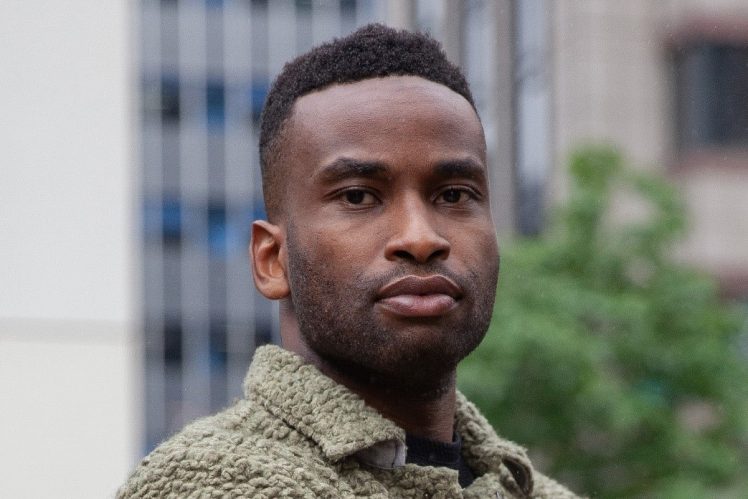The architect at construction consultancy Mace Group saw off Sumita Singha, who also stood for the post two years ago, and Allies and Morrison’s Jo Bacon in the race to succeed Simon Allford.
Oki was elected on the second round of voting after Singha had been eliminated and her votes redistributed by second preferences. He picked up 49.3 per cent of the vote compared with 45.4 per cent for Bacon. Oki will start his two-year term on 1 September 2023.
He previously worked at Grimshaw Architects, where he founded and chaired the practice’s multi-ethnic group and allies network. Aged just 31, he is the youngest ever RIBA president since the role was established in 1835.
Speaking after hearing the result today, Oki said he was grateful to the ‘grassroots movement whose support and passion offered a platform to represent architectural workers’.
He said: ‘Most of all a special thanks to those members and nominators that responded to this movement, tuned in, and voted – especially those that did so for the first time. We can be proud of an election where people of colour, at different stages of their careers, of all identities, can be heard and seen bidding to represent the profession.’
He added: ‘I hope this is the start of many great things to come for those who feel disenfranchised and under-represented. I am proud of my campaign, the discourse has been positive, energetic, and inspirational. It has been a privilege to run alongside Jo and Sumita and, as RIBA Council and Board members, I am looking forward to working with you both to deliver equity, transparency, and innovation in architecture.’
Oki was put forward as a potential candidate in May after being chosen by an informal collective of
early-career architects, students and architectural activists keen to shake up the institute and move it beyond ‘empty slogans and self-serving initiatives’.
Responding to the news, current president Allford, praised Oki for leading a ‘commendable campaign with an electoral manifesto focused on the future of the profession’.
He said: ‘This is an exciting time for RIBA as we shape a leaner, more agile organisation to support our global membership and engage all those with an interest in architecture.’
The turnout for the election was 12.4 per cent (compared with 13.2 per cent two years ago when Allford was elected) with a total of 6,020 votes cast. In the first round, Oki led with 40.7 per cent of votes, followed by Bacon with 38.4 per cent while Singha received 20.7 per cent. She was then eliminated and her second preferences redistributed.
How Muyiwa Oki answered the AJ’s questions in July
Why did you decide to run?
I put myself forward for nomination at the urging of a few friends. I really do think our profession can change for the better – but I didn’t expect I’d be selected by grassroots lobbying to speak up for the future architect in this election.
The presidency has become a status symbol rather than a position of representation or change
I’m so pleased that I was. It’s a huge opportunity to work with people from across the industry to change our profession for the better. One of my key goals is to see a shift of mindset in the architecture community – driven by the RIBA – to make architecture a more dynamic and sought-after profession for the next generation; to speak up for the future architect; to tap into the energy and voice of unheard and underrepresented members.
What advice have you received from those supporting your candidacy – and what lessons have you learned from previous presidents?
A number of past-presidents have been really supportive. That took me by surprise. A special shout out to Ben Derbyshire for his public support – it really means a lot. A few people have said: ‘Why do you feel like you can lead our profession?’ Ben gave me a great retort line: ‘There is nothing more effective than someone arguing from lived experience.’
I’ve learned some key lessons on how to be strategic but, most importantly, how to go after and address your key constituents.
What is the single biggest thing you’d like to achieve during your presidency?
I’d love to be able to say that we’d helped to ensure younger members had a better work/life balance and had more time to engage meaningfully with the work RIBA does.
How would you make the RIBA more transparent, open and inclusive?
Through a series of RIBA quarterly town halls for transparency and member engagement; pushing for decentralisation and regionalism; pushing back against the London-centric operating of the institution; opening council meetings to the architectural press – where there is a need for in-camera decisions, there should be a separate meeting.
How will the RIBA’s current cost-cutting drive affect what is achievable as president?
It shouldn’t. There are some very easy wins that won’t cost the earth – we just need to be smart about how we address some of the challenges we face.
Will you continue with the plans to spend £20 million on the revamp of 66 Portland Place to create a House of Architecture? Is it a good way to spend members’ money?
As the outsider candidate, it’s something that I am committed to understanding more about if I am elected president. It’s always difficult to understand the details of any building project when you’re on the outside, as many members will recognise!
How will you tackle the perception that the RIBA remains London-centric? And how can it re-engage with its members?
It’s something that I think is hugely important and one of the main driving forces behind my manifesto. We should be a truly global organisation, but we’ll only get there by making the regions the stars, with a push for a decentralised mode of operating.
How important is it that the RIBA president is popular? Are you prepared to ruffle feathers to bring about change?
Very important. The president is an ambassador, a champion, the maverick. The representative of the members. Therefore you have to pick the issues that have impact and you have the ability to get it done. I reckon some feathers feel ruffled already – but change is the only constant.
How will you know if you have achieved success?
With my single-minded focus on driving engagement, success will be with the growth in engaged members. A much richer, much younger, much more diverse cohort of members.
Archtectjouranal.co.uk













